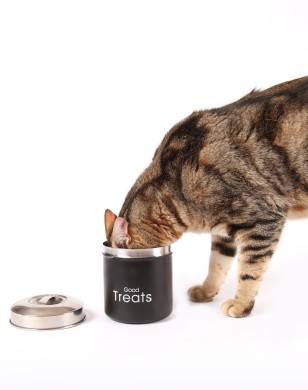Calories count for felines, too.
By Sandy Robins

There’s no question that giving treats to your adoring and appreciative feline is very much a part of the human-animal bonding experience.
But it’s important to remember that all treats have calories. This must be taken in to account in determining your cat’s daily food allowance. Fortunately, manufacturers are cognizant of this, too, and many go to great lengths to put the number of calories per treat prominently on their packaging. So, it’s entirely up to you to establish the desired number to dish out daily in terms of your pet’s optimal weight and health.
There is also no shortage of types of treats in terms of tastes and textures. And, in order to make the reason for treating cats on a regular basis more “palatable” to pet parents, manufacturers have added a silent “ingredient” to treats: functionality. That’s part of the reason there is a slew of treat products with special ingredients that claim to help prevent ailments such as tartar buildup, bad breathe or even hairballs.
Instead of indiscriminate treating, it’s a good idea to give your feline specific reasons to expect a reward. Grooming is a perfect example. While most cats enjoy long massaging brushing strokes, they often get wriggly when its time for that mani-pedi. To make nail clipping more pleasurable, treat your cat when it’s over and eventually she will begin to realize there is something good about the whole process. In addition, rewarding only for good behavior also helps control the number of treats you give your cat on a regular basis.
I use Fudge’s favorite freeze-dried fish treats as an incentive to get her to sit still for a couple of minutes twice a week when I have to give her subcutaneous fluids. From being totally resistant, she’s now tolerant of the procedure.
As people become more aware that it’s possible to train cats—even if it’s something as simple as getting them to sit on command—a treat is a wonderful reward for an action well done. Consequently, treats are very much a part of the popular clicker-training process whereby cats (and dogs) are trained using the click-and-treat positive-reward methodology.
Cats in the wild are used to hunting and working for food. Consider setting out a treasure hunt in your home by hiding treats and some of your cat’s favorite toys in different locations. This is a great way to prevent boredom and keep her engaged and “on the hunt” when she is home alone. You can also hide treats in specially designed cat puzzle toys or treat balls to keep the games going. And, if your cat has a favorite treat, change things up by trying different ones from time to time.
Another way to control treats—and prevent you from handing them out indiscriminately all day— is to use them to build a routine. I have a friend who likes to treat her three felines just before her bedtime. The cats know this and line up in front of the treat drawer every evening at 10:00 pm.
There might be occasions when your veterinarian says “No treats—ever,” for health reasons. However, you can take a small percentage of your cat’s daily kibble allowance and use it as a substitute for actual treats. By doing so, she still gets to enjoy the treating process without countering the vet’s instructions.
Finally, be sure to store your treats in a well-sealed treat jar, in a kitchen drawer or closet. You want to make sure your feline’s ingenuity for getting into things won’t enable her to party until the packet is finished, defeating your goal of keeping everything under control.
About the Author: Sandy Robins is the 2013 winner of the “Excellence in Journalism and Outstanding Contribution to the Pet Industry Award.” Her work appears on many of the country’s leading pet platforms, such as MSNBC.com, MSN.com and TODAYShow.com. She is a regular contributor and columnist in multiple national and international publications, including Cat Fancy, as well as the author of the award-winning books “Fabulous Felines: Health and Beauty Secrets for the Pampered Cat” and “For The Love of Cats.” Learn more about Sandy on her website or Facebook page. #welovecats




